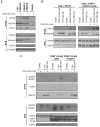The interferon signaling antagonist function of yellow fever virus NS5 protein is activated by type I interferon
- PMID: 25211074
- PMCID: PMC4176702
- DOI: 10.1016/j.chom.2014.07.015
The interferon signaling antagonist function of yellow fever virus NS5 protein is activated by type I interferon
Abstract
To successfully establish infection, flaviviruses have to overcome the antiviral state induced by type I interferon (IFN-I). The nonstructural NS5 proteins of several flaviviruses antagonize IFN-I signaling. Here we show that yellow fever virus (YFV) inhibits IFN-I signaling through a unique mechanism that involves binding of YFV NS5 to the IFN-activated transcription factor STAT2 only in cells that have been stimulated with IFN-I. This NS5-STAT2 interaction requires IFN-I-induced tyrosine phosphorylation of STAT1 and the K63-linked polyubiquitination at a lysine in the N-terminal region of YFV NS5. We identified TRIM23 as the E3 ligase that interacts with and polyubiquitinates YFV NS5 to promote its binding to STAT2 and trigger IFN-I signaling inhibition. Our results demonstrate the importance of YFV NS5 in overcoming the antiviral action of IFN-I and offer a unique example of a viral protein that is activated by the same host pathway that it inhibits.
Copyright © 2014 Elsevier Inc. All rights reserved.
Figures







Comment in
-
Flavivirus NS5 Prevents the InSTATement of IFN.Cell Host Microbe. 2014 Sep 10;16(3):269-71. doi: 10.1016/j.chom.2014.08.011. Cell Host Microbe. 2014. PMID: 25211068
References
-
- Arimoto K, Funami K, Saeki Y, Tanaka K, Okawa K, Takeuchi O, Akira S, Murakami Y, Shimotohno K. Polyubiquitin conjugation to NEMO by triparite motif protein 23 (TRIM23) is critical in antiviral defense. Proceedings of the National Academy of Sciences of the United States of America. 2010;107:15856–15861. - PMC - PubMed
Publication types
MeSH terms
Substances
Grants and funding
LinkOut - more resources
Full Text Sources
Other Literature Sources
Molecular Biology Databases
Research Materials
Miscellaneous
